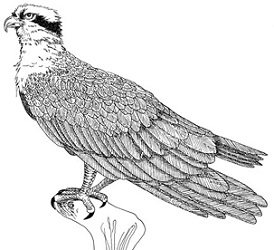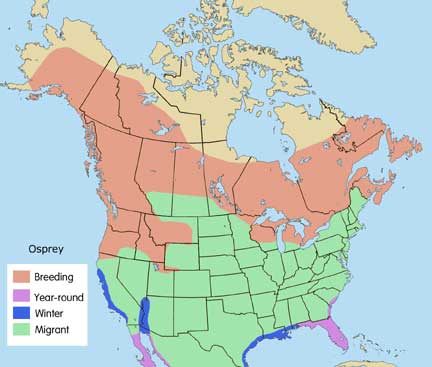
Scientific Name: Pandion haliaetus
This large, vocal bird is difficult to mistake for any other species, except while on the nest, when its white head seen sticking up could make a viewer think of a bald eagle. However, where these birds put their nest is a dead give-away that it’s an osprey. The bird is dark on the back, almost uniformly white on the chest and belly, save for a dark ‘necklace’ of varying proportions, more usually on the female. Head is white with a dark eye line; wings in flight often in an ‘M’ shape as it soars or hovers over water. When perched, the tips of the long wings extend past the tail. Bill is black and short, powerful legs and feet grey. Close up or in the hand, other distinctions that separate this bird from other raptors are sharp spicules on the scales on the undersides of the feet and toes; very curved talons that are, in cross section, uniquely rounded; and unusually long, slitlike, closable nostrils (nares). Immature birds have orange eyes, that change to the adult yellow in their second year, with a buffy edge to the back and wing covert feathers that wears off during their first winter. The osprey is a very old species, thought to have broken off from the ancestral accipitriform before any of the other diurnal raptors radiated off, and is considered closer to the hawks, even more so to the kites, than to the falcons.
Male
Length: 17 – 22″
Wingspan: 56″
Weight: 2.4 – 3.8 lb.
Female
Length: 19 – 24″
Wingspan: 60″
Weight: 2.6 – 4.4 lb.
[Osprey Hatchling] Improving; listed in 12 states as endangered, threatened or a species of special conservation concern. Numbers plummeted and the species was extirpated in many areas in the middle of the last century because of DDT, as well as the development of coastlines and resulting loss of nesting snags. This species has responded very well to artificial nesting platforms. Because, like the bald eagle, birds return to their natal area once they reach breeding age, reintroduction programs have been successful by using young birds taken from nests in areas where the population is healthy and then hacking them out in their new territory.
Near water, especially water with extensive shallow areas; often found in large numbers around man-made reservoirs, inland lakes, rivers, river deltas, coastal regions. Need snags or other elevated nesting sites with clear access to the water.
Primarily fish, though remains of other prey have been found in nests, and anecdotal sightings exist of them hunting squirrels or even pigeons. One of the most specialized birds of prey, it plunges into water both head- and feet- first. Powerful flight is needed when taking off after catching prey. Specialized flight muscles allow the osprey to get airborne out of the water while grasping heavy prey items, often then shaking the water off their feathers while in mid-air flight. Bald eagles diving that deep would have to swim to shore.
Common call is a loud, whistled Kyew, kyew, kyew, kyew, kyew. Female calls are generally stronger and lower pitch than males, which may be due to the females’ larger body size.
Osprey are versatile nest users and will use a variety of tall structures, both natural and artificial, to avoid mammalian p redation. Natural sites include tall trees, cacti and rock towers. Increasingly, they use artificial structures such as channel markers, cell-phone towers and utility poles, as well as artificial nest platforms erected especially for osprey. Nests are never far from shallow water, as their primary prey item is fish. Nest selection is often within a commutable distance to fishing grounds (10-20 km). Males generally select nest sites and begin building the wood stick nest before the arrival of females. Females will arrange the materials in the nest. Males and females share incubation of the 1-4 eggs, with the female spending significantly more time in the nest while the male continues hunting for the family.
Species numbers have been increasing in recent decades due to the ban of DDT in North America and the increase in artificial nest sites. Levels of organochlorine pesticides (DDT/ DDE) can still be high in some birds who live near heavily agricultural or industrial sites in the Northeast U.S. Some individuals may also be exposed to these chemicals on their wintering grounds in Central and South America. Organochlorine pesticides are persistent in the body and have been linked to lowered reproductive success in many raptors. Historically shot in North America (though fewer birds reported killed in this way in recent years), shooting is still a major cause of death in Central and South America. Collisions with power lines often found near dams, as well as other stationary and/or moving objects are a problem, especially for younger birds. Electrocutions are possible when adults land or attempt to nest on power poles with transformers, which may be the highest perches in the area. Utility companies usually are very willing to put up nesting platforms, as such a platform installed just a little bit higher than the power pole will successfully lure the birds away from the electrical lines.

Essentially world-wide.
Special Thanks for range maps:
Dan Gleason
BGleason Design & Illustration
Commercial & Scientific Illustration, Graphic Design
CraneDance Communications
Book Production/Design

